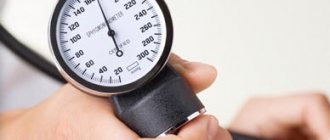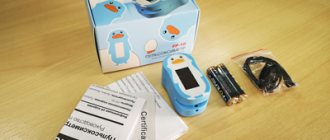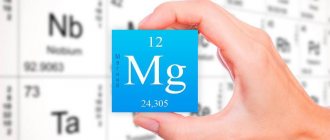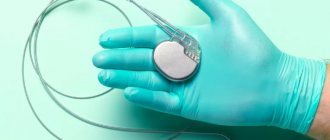The implantation of an electrical pacemaker in Tver is carried out by a cardiovascular surgeon, candidate of medical sciences, Ilya Borisovich Lukin.
To make an appointment with a cardiac surgeon, as well as to find out the cost of the appointment, you can call:
- 8 (Research Institute “Phlebology”, Tver, 2nd Krasina St. 49)
- 8 (University Clinic, Tver, Peterburgskoye Highway, 115 building 2)
Implantation of an electrical pacemaker (Pacemaker) is the most reliable and often the only method for treating bradycardia. In the Tver region, about 1,000 people annually need this operation. Unfortunately, the capacity of Tver healthcare is only sufficient for 200 implantations per year.
Pacemaker installation
Despite the fact that implantation of a pacemaker is essentially an operation on the heart and large vessels, it is classified as minimally invasive surgical interventions .
This is not open heart surgery. The surgeon only needs a small and shallow incision up to 5 cm long, which is usually made under the collarbone. During pacemaker implantation, local anesthesia . You can usually leave the clinic and return home 24 hours after the procedure.
What does the price depend on?
The cost of the operation depends on the chosen clinic and package of services . In a regular hospital, a surgeon will install a pacemaker for free, but it is the patient’s job to buy it.
In private clinics, in addition to the pacemaker, you will also need to pay for the services of a surgeon. Since there are pacemakers of various equipment, the price of modern models with greater functionality will be higher.
Indications for pacemaker installation:
A pacemaker is placed only in cases where there is a real risk to the life and health of the patient.
To absolute indications
The following diseases are included in the operation to install a pacemaker: • bradycardia with clinical symptoms (dizziness, fainting - syncope, Morgagni-Adams-Stokes syndrome, MAS); • recorded decrease in heart rate (HR) to values less than 40 during physical activity; • episodes of asystole according to the electrocardiogram (ECG) lasting more than 3 seconds; • persistent atrioventricular block of II and III degrees in combination with two or three fascicle blocks or after myocardial infarction in the presence of clinical manifestations; • any types of bradyarrhythmias (bradycardias) that threaten the life or health of the patient and in which the heart rate is less than 60 beats per minute (for athletes - 54 - 56).
Indications for pacemaker placement are rarely heart failure.
, in contrast to
the cardiac arrhythmias
that accompany it. In severe heart failure, however, we may be talking about asynchronous contractions of the left and right ventricles - in this case, only the doctor decides on the need for surgery to install an pacemaker.
Relative readings
for pacemaker implantation: • atrioventricular block of the second degree, type II, without clinical manifestations; • third degree atrioventricular block at any anatomical site with a heart rate under load of more than 40 beats per minute without clinical manifestations; • syncope in patients with two- and three-fascicle blocks not associated with ventricular tachycardia or complete transverse block, with the impossibility of accurately identifying the causes of fainting.
If there are absolute indications for implantation of a pacemaker, the operation is performed on the patient as planned after examination and preparation, or urgently. There are no contraindications to pacemaker implantation in this case.
If there are relative indications for implantation of a stimulator, the decision is made individually, taking into account, among other things, the patient’s age.
Are not indications
for the installation of a heart pacemaker by age, the following diseases: • atrioventricular block of the first degree, • atrioventricular proximal block of the second degree, type I without clinical manifestations, • drug blockade.
Pacemaker: expiration date
The lifespan of a pacemaker is determined by the battery capacity. It is designed for 7-10 years of operation. In most cases, when the battery life is approaching, the device will sound an alarm during the next scheduled examination. After this, the patient should replace the battery with a new one.
Most often, medical practice shows that people with a pacemaker installed, subject to all doctor’s recommendations, live no less than other people. But still, a patient with a pacemaker should adhere to certain rules. Therefore, the question of how long people live with a pacemaker depends on the regularity of visiting the doctor and following the recommendations given to the patient.
You need to visit a cardiologist after surgery:
- Three months after installation of a pacemaker;
- Six months after the first post-operative visit;
- Once every six to twelve months for a routine inspection;
- Unscheduled - in cases of sensation of electrical discharges, return of symptoms of the original illness, appearance of signs of inflammation at the site of installation of the device;
- After the pacemaker's stated service life has expired. Usually it is 6-15 years.
How are electrodes placed in the heart?
In order to install electrodes into the heart muscle through which the pacemaker will send impulses, it is not necessary to undergo severe traumatic open-heart surgery. The pacemaker and electrode are installed through one small incision. The electrode is passed into the chambers of the heart through blood vessels, usually the subclavian vein. In this case, an incision is made in the upper chest, under the collarbone. Once the end of the electrode is in the right place, it is attached to the wall of the heart using a special fixation system: anchors in the form of a hook (passive fixation) or using a corkscrew-shaped spiral (active fixation). Sometimes electrodes are inserted through other vessels: axillary, internal jugular vein, etc.
Main features of Medtronic pacemaker:
According to the manufacturer, they stimulate the heart in a completely physiological mode. • all device functions are automated; • constant monitoring of electrode polarity, impedance, stimulation thresholds is carried out; • the device automatically monitors the electrical activity of the heart and adjusts its work to it.
A cardiologist-arrhythmologist at City Clinical Hospital No. 31 checks and adjusts an already installed Medtronic pacemaker and installs an pacemaker.
If you already have a pacemaker , please provide the model when making your appointment so that your doctor can prepare the necessary equipment to test the pacemaker.
If you do not know whether you need a pacemaker, but you are concerned about heart failure , make an appointment with an arrhythmologist, and the doctor will select the necessary treatment.
You can read about how to prepare for an appointment with an arrhythmologist
How is a pacemaker installed?
Modern ECs are small in size, so their installation is not difficult.
The surgeon makes an incision about 3-4 cm long under the collarbone, creates a pocket under the pectoral muscle and places an artificial pacemaker in it. An electrode delivery system—intraducers—is installed into the vein, through which the electrodes are inserted and fixed into the heart cavity (under X-ray monitoring). The connector part of the electrodes is connected to the body of the device. After this, the wound is sutured. To ensure that the pacemaker and electrodes are positioned correctly, a control fluoroscopy is performed.
What is a pacemaker
With age, the heart, like any muscle, wears out . Decreased quality of life can be corrected by installing a pacemaker. It is a small microprocessor in a sealed titanium case.
The pacemaker is inert in relation to the biological environment of the body, which means the risk of rejection is minimal.
The pacemaker has several parts:
- The power supply can be compared to a battery. The service life is about 7 years.
- Microprocessor – converts electricity into impulses to stimulate the heart.
- A block with conductors and electrodes are impulse conductors. They come into direct contact with the surface of the heart.
- Programmer – controls the operation of the stimulator. It is used to adjust the device settings for various changes in heart rhythm - tachycardia, bradycardia, fibrillation.
The implant is placed under the skin or muscle. It helps maintain a normal heartbeat. Modern models are autonomous - they detect the electrochemical activity of the heart and, in case of deviations, create an additional electrical charge. Doctors call this method “resynchronization therapy.” The entire operation lasts 1.5–2 hours .
What complications occur after implantation of pacemakers? And how can you prevent them?
Like any surgery, pacemaker implantation carries certain risks.
1. By making a skin incision, an infection . In order to prevent possible infection, before the operation the doctor administers an antibacterial drug to the patient, and the surgical field is treated with modern antiseptics. 2. In very rare cases, if the pleura, the film that ensures the tightness of the chest cavity, is damaged, air can penetrate into the latter due to the negative pressure inside. This condition is called pneumothorax . The air compresses the lungs, prevents them from expanding and makes breathing difficult. This can be eliminated by installing pleural drainage and pumping out air. In order to make sure that there is no such complication, or to detect and eliminate it in time, the doctor prescribes a chest x-ray after the operation. pain may occur when moving your arm , but usually it is not severe and passes quickly. If necessary, painkillers are prescribed for several days. 4. Next to the subclavian vein is the subclavian artery. Due to the individual anatomy of each patient, the surgeon can inject it with a puncture needle. Then there will be a hematoma (bruise) in the subclavian region, along the biceps and under the chest, which, as a rule, resolves after 7-10 days. 5. Some patients develop allergic reactions to medications or materials used during implantation. If a severe allergy (anaphylactic shock) occurs, doctors will interrupt the operation and provide assistance . Surgical treatment is carried out accompanied by an experienced anesthesiologist and resuscitator. 6. Hemorrhage under the skin . It will go away in a few days, there's nothing to worry about.
Modern technologies and small sizes of pacemakers make it possible to minimize risks, make implantation quick and painless, less traumatic, and reduce postoperative rehabilitation time. Still, this is a serious procedure. The quality of life of the patient in the future depends on how successfully it is performed.
Pacemaker: complications
According to statistics, complications after the installation of a pacemaker occur in no more than 3-5% of cases. Critical situations during this procedure may arise both during and several days, even weeks after the operation.
The following complications may occur directly during the operation:
- allergic reaction to anesthetic;
- development of pneumothorax (formation of an air pocket in the lungs);
- damage to blood vessels and nerve endings.
The occurrence of complications during the installation of a pacemaker leads to the patient being transferred to the intensive care unit for approximately 2-3 days.
Early postoperative complications:
- Development of thromboembolism - closure of the lumen of the pulmonary artery with a thrombus;
- Development of bleeding;
- Insulation failure, displacement, fracture of the electrode;
- Development of infection of the surgical wound area.
Long-term complications:
- The appearance of shortness of breath, dizziness, decreased blood pressure, occasional loss of consciousness;
- Development of tachycardia caused by pacemaker;
- Premature failures in the ECS.
The operation to implant a pacemaker should be performed by an experienced surgeon under X-ray guidance. After discharge from the hospital, the patient is required to undergo regular examinations and be registered with a dispensary.
Advantages of treatment at City Clinical Hospital No. 31:
1. To control the position of the electrodes during surgery, the doctor uses not a C-arm (X-ray machine), but a modern angiograph, reducing the radiation dose to the patient by tens of times . 2. High requirements for the sterility of the operating room . City Clinical Hospital No. 31 is a state medical institution, which means it is subject to increased sanitary requirements. Regular cultures are carried out to check the growth of bacterial flora, and the quality of treatment of surgical premises, instruments and consumables is monitored. The risk of the patient contracting a bacterial or viral infection is reduced to zero. 3. Surgical treatment is carried out accompanied by an experienced anesthesiologist-resuscitator . Since the patient is conscious during the operation, the conditions for a comfortable stay are strictly observed. Continuous monitoring of hemodynamic parameters ensures patient safety. 4. The many years of experience of our cardiovascular surgeons and the high level of equipment in the operating rooms allows us to carry out the operation to install a pacemaker as safely as possible to avoid possible complications. 5. For the postoperative period, patients are provided with superior wards in the cardiology department of City Clinical Hospital No. 31 . Postoperative observation is carried out for 1 day after surgery, and then the patient can go home. 6. The operating arrhythmologist is always available to the patient if he has questions or requires an assessment of the pacemaker’s performance.
Get treatment from professionals!
Pacemaker: life after surgery
Installation of a pacemaker, although not long, is still a difficult operation. Therefore, in the postoperative period, a patient with an pacemaker has a number of restrictions regarding physical activity and electromagnetic factors, which have a negative effect on the operation of the device. Before any examination or course of treatment, it is necessary to warn doctors about the presence of an pacemaker.
Living with a heart pacemaker imposes the following restrictions on a person:
- You cannot undergo an MRI;
- You cannot engage in sports that are fraught with the development of injury;
- You must not approach transformer booths;
- You cannot put a mobile phone in your breast pocket;
- You should not stay near metal detectors for a long time;
- You cannot undergo shock wave lithotripsy without first setting up an pacemaker or perform electrocoagulation of tissues during surgery.
In addition to the recommendations described above, the patient should always carry a pacemaker passport with him. In case of emergency situations and emergency care for the patient, the doctor must be aware of the type of pacemaker and the reason why it was installed.
The patient is recommended to remain at a distance of at least 15-30 cm from sources of electromagnetic radiation - TV, cell phone, hair dryer, electric razor and other electrical appliances.
The presence of an installed pacemaker is not a contraindication for pregnancy. Despite this, the patient needs to be monitored by a cardiac surgeon throughout her pregnancy. In such cases, delivery must be carried out by caesarean section as planned.
Also, a patient with a pacemaker may be assigned a disability group. It is approved only if the patient’s working conditions are determined by the clinical expert commission to be severe or potentially dangerous (that is, they may harm the stimulant). For example, work using electric welding or electric steel-smelting machines, or other sources of electromagnetic radiation.
Cost of services of an arrhythmologist
| Payment code | Nomenclature of the Ministry of Health and Social Development | Name | Price, rub.* |
| 1089 | B01.043.003 | Appointment (examination, consultation) with a doctor for X-ray endovascular treatment of cardiac arrhythmias | 4 300 |
| 1090 | B01.043.004 | Appointment (examination, consultation) with a doctor for X-ray endovascular treatment of cardiac arrhythmias with checking the operation of the pacemaker | 6 100 |
| 9004 | A05.10.006 | Electrocardiogram registration | 1 600 |
| 9006 | A05.10.008 | Holter heart rate monitoring (HM-ECG) | 4 800 |
| 15023 | A16.10.014.003 | Implantation of a two-chamber pacemaker (pacemaker), without the cost of the electrode and pacemaker | 125 000 |
Sign up for a paid appointment
Complications in the future
Pacemaker complications include failure due to mechanical factors such as pneumothorax, pericarditis, infection, skin erosion, hematoma, lead migration, and venous thrombosis.
Treatment depends on the etiology. Pneumothorax may require medical observation, needle aspiration, or even chest tube placement.
Late procedure-related complication
- Pocket erosion
- Electrode offset
- Hematoma
- Phlebitis/deep vein thrombosis
- Infection
- Hemothorax
- Atrioventricular fistula
- Subclavian crush syndrome
Late device-related complications
- Pacemaker/oscillator infection.
- Systemic infection.
- Myocardial perforation.
- Twiddler syndrome.
- Pacemaker syndrome.
- Allergy or sensitivity to unit components or electrodes.
- Electrode fracture.
- Breast muscle stimulation.
- Intercostal or diaphragmatic stimulation.
- Endocarditis.
- Right atrial thrombus.
4.Can electrical devices affect the operation of a pacemaker?
A pacemaker is an electrical device. And there are certain rules for its interaction with other electrical appliances:
- Electric blankets, heating pads, and microwave ovens will not affect the pacemaker;
- The cell phone must be used on the side opposite to the place where the pacemaker is implanted. The phone should not be worn directly on the chest (for example, on a lanyard) or on the same side of the body where the pacemaker is implanted;
- You will have to avoid strong electric or magnetic fields. For example, some industrial equipment, large electrical generators, power plants, radio frequency towers and arc resistance welders.
- You cannot undergo a medical examination with an MRI.
In any case, the doctor will tell you about this specificity in more detail.
2.How to prepare for implantation, implantation methods
Before having a pacemaker implanted, talk to your doctor about the medications you take on an ongoing basis. Your doctor may ask you to temporarily stop taking them 1-5 days before your procedure.
Do not eat or drink after 12:00 am immediately before your procedure. If you must take the medicine, take it with a small sip of water.
Pacemaker implantation methods
Pacemaker implantation can be performed in two ways:
- Endocardial method of pacemaker implantation.
It is used most often. A local anesthetic is used to numb the area where the pacemaker is implanted. An incision is made in the chest and the device is inserted into the desired area. Pacemaker wires are inserted through an incision into a vein and then guided toward the heart using fluoroscopy. One end of the wire is attached to the heart muscle, and the other to the pulse generator. - The epicardial pacemaker implantation method
is more often used in children than in adults. The procedure is performed under general anesthesia.
Visit our Cardiology page
Efficiency forecast and service life
Pacing is the only effective long-term treatment for symptomatic bradycardia. The clinical benefit of PM therapy in patients with symptoms of atrioventricular block was evident from the very beginning.
Because of the magnitude of the treatment effect, there was no need for randomized trials to prove its effectiveness.
Later, the use of PM therapy was expanded to include other types of bradycardia such as SSS and AF. These arrhythmias represent a heterogeneous combination of conditions characterized by varying degrees of severity and a variety of symptoms, ranging from intermittent syncope to acute cardiac arrest.
No rigorous clinical trials have ever been conducted to determine the clinical effectiveness of PM therapy in these settings. International recommendations are mainly based on expert opinion. For some indications, such as SSS with prolonged ventricular pauses complicated by recurrent syncope, indirect evidence indicates a clear symptomatic benefit.
However, for conditions such as slow AF and lower levels of AV block, especially in patients who have no or mild pacing symptoms, the benefit of pacing is less clear.
Randomized trials of PM therapy were conducted in the 1990s and early 2000s, but these only compared the clinical effectiveness of different stimulation modalities
(eg, single or dual chamber stimulation), and they did not consider the actual effectiveness of the method.
In 2005, NICE published a technology assessment of the use of dual-chamber PM17s. She concluded that dual-chamber pacing is generally preferable to single-chamber pacing, except in certain groups of patients in whom, after complete evaluation, there is no evidence of AV conduction abnormality.
A 2004 Cochrane review found that pooled data from parallel studies showed a statistically significant preference for stimulation for the prevention of stroke, heart failure, and all-cause mortality, and a statistically significant benefit for the prevention of AF.
Pooled data from cross-sectional studies showed a statistically significant trend that pacing was more beneficial in terms of exercise performance.
The service life of modern pacemakers is 8-10 years. this applies to both classic models with electrodes and electrodeless ones.









